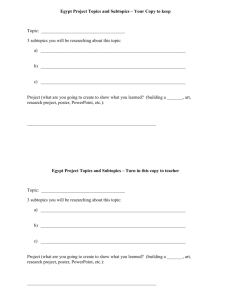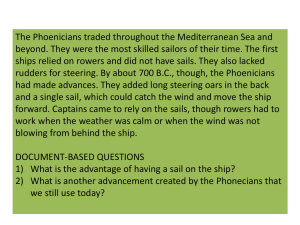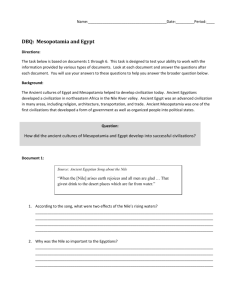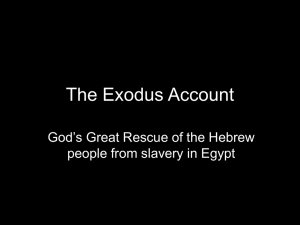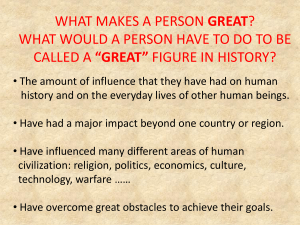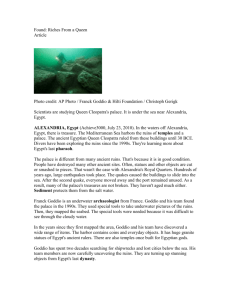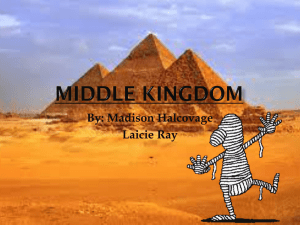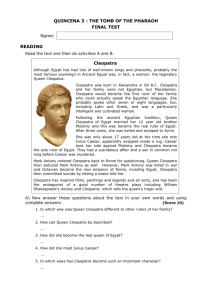6 th Grade Social Studies Study Guide for Midterms 2012-2013
advertisement
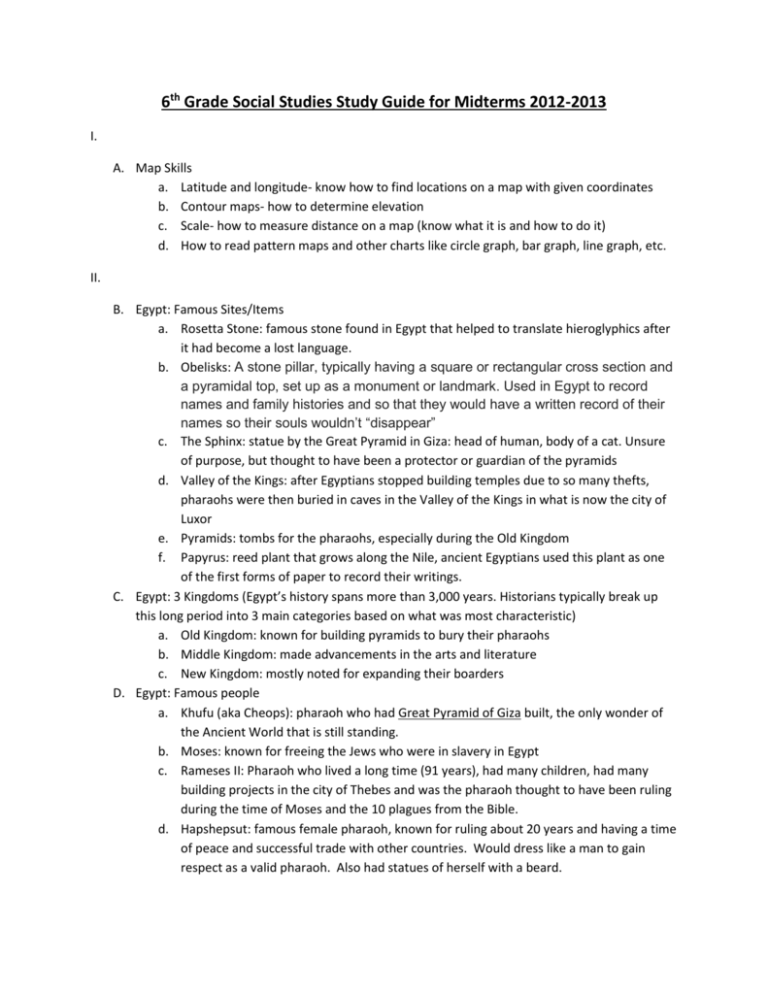
6th Grade Social Studies Study Guide for Midterms 2012-2013 I. A. Map Skills a. Latitude and longitude- know how to find locations on a map with given coordinates b. Contour maps- how to determine elevation c. Scale- how to measure distance on a map (know what it is and how to do it) d. How to read pattern maps and other charts like circle graph, bar graph, line graph, etc. II. B. Egypt: Famous Sites/Items a. Rosetta Stone: famous stone found in Egypt that helped to translate hieroglyphics after it had become a lost language. b. Obelisks: A stone pillar, typically having a square or rectangular cross section and a pyramidal top, set up as a monument or landmark. Used in Egypt to record names and family histories and so that they would have a written record of their names so their souls wouldn’t “disappear” c. The Sphinx: statue by the Great Pyramid in Giza: head of human, body of a cat. Unsure of purpose, but thought to have been a protector or guardian of the pyramids d. Valley of the Kings: after Egyptians stopped building temples due to so many thefts, pharaohs were then buried in caves in the Valley of the Kings in what is now the city of Luxor e. Pyramids: tombs for the pharaohs, especially during the Old Kingdom f. Papyrus: reed plant that grows along the Nile, ancient Egyptians used this plant as one of the first forms of paper to record their writings. C. Egypt: 3 Kingdoms (Egypt’s history spans more than 3,000 years. Historians typically break up this long period into 3 main categories based on what was most characteristic) a. Old Kingdom: known for building pyramids to bury their pharaohs b. Middle Kingdom: made advancements in the arts and literature c. New Kingdom: mostly noted for expanding their boarders D. Egypt: Famous people a. Khufu (aka Cheops): pharaoh who had Great Pyramid of Giza built, the only wonder of the Ancient World that is still standing. b. Moses: known for freeing the Jews who were in slavery in Egypt c. Rameses II: Pharaoh who lived a long time (91 years), had many children, had many building projects in the city of Thebes and was the pharaoh thought to have been ruling during the time of Moses and the 10 plagues from the Bible. d. Hapshepsut: famous female pharaoh, known for ruling about 20 years and having a time of peace and successful trade with other countries. Would dress like a man to gain respect as a valid pharaoh. Also had statues of herself with a beard. e. King Tutankhamen: (King Tut for short) young pharaoh whose tomb was found in tact in 1922 by Henry Carter. His famous tomb filled with gold and riches has since made him very famous. Died when he was young, most likely around the age of 18. f. Imhotep: first architect of the pyramids. Was also an inventor, priest, dentist, etc. g. Cleopatra: last pharaoh of Egypt. Had a public affair with Rome’s first emperor, Julius Caesar, but then he is murdered. His adopted son, Augustus then become’s Rome’s emperor and seeks the help of General Marc Antony to help rule the Roman Empire. Marc Antony is sent to Egypt where he falls in love with Cleopatra. Augustus fears Marc Antony will betray him and side with Cleopatra to take over Rome. Augustus sends troops to fight them (Battle of Actium). Seeing defeat, Cleopatra and Marc Antony retreat and decide to commit suicide instead of facing the punishment of the Roman army. Cleopatra is famously rumored to have put her hand in a basket with a poisonous snake (an asp) and let the snake bite her. Marc Antony “falls on his sword” (or stabs himself with his sword) E. Egypt’s Social Hierarchy: (top to bottom) a. Pharaoh b. Priests/artisans(skilled workers) c. Farmers/unskilled workers/laborers d. Slaves III. A. Mesopotamia a. Epic of Gilgamesh story- know the content b. Characters: i. King Gilgamesh ii. Friend: Enkidu iii. Forest monster: Humbaba iv. Goddess: Ishtar v. Old man: Utnapishtim 1. Setting: Sumer, in the city of Uruk 2. Theme: Can one live forever? And/Or One of having a true friend c. Needed vocabulary: i. Ziggurats: step temples, where the people of Mesopotamia believed the gods (or a specific god, depending on the city) lived on the top ii. Caravans: groups of people traveling together for safety, often times with camels iii. Irrigation: a method of transporting water from one place to another for crops iv. Astronomers: people who study the stars and planets v. City-states: cities that had their own system of government and rules. Ruled themselves. d. Geography: i. 2 Major Rivers 1. Tigris 2. Euphrates 3. Surrounded by desert (Arabian Desert) and Mountains (Zargos Mts) 4. Rare or needed items: wood and metal e. Famous People/Groups: i. Sumerians: One of the first civilizations believed to exist on Earth. Had many advancements such as: 1. Farming/irrigation systems 2. Writing system (Very Important) 3. Made a number system based on 60 4. Studied the stars to help them know when best to plant crops ii. King Hammurabi: Creator of Hammurabi’s code. A law system that would punish criminals based on a written record so that there was no favoritism for the wealthy. The basis for many law codes today. iii. Assyrians: violent group of people who were able to conquer most of the Mesopotamian region. Many people were unhappy with Assyrian rule because of their harsh rule. Capital: Nineveh iv. Chaldeans: group from Sumer area who eventually defeated the Assyrians. New Capital: Babylon v. King Nebuchadnezzar: Chaldean king who ruled much of Mesopotamia. Famous for building the Hanging Gardens for one of his favorite wives. Is considered to be one of the 7 wonders of the Ancient World. vi. Mesopotamia was later conquered by the Persians. IV. Greece A. Myths to know: a. Medea (woman who sought revenge after her husband left her for another woman by killing the other woman (Glauce), her father (King Creon-who proposed the idea), and Medea and Jason’s children. b. Jason and the Argonauts- Jason has to obtain the golden fleece and go on an epic adventure to gain his rightful place as king of his home town. He gains Medea’s help and her hand in marriage in the process. c. The Judgment of Paris: Paris must choose who is the most beautiful goddess between Athena, Hera, and Aphrodite and then award her the golden apple of discord. Each of the goddess offer him different gifts in exchange for the apple, however Aphrodite wins by offering him Helen, the most beautiful woman on Earth at the time. This decision however, starts the beginning of the Trojan War. B. Architecture: a. Three types of columns: i. Doric: most simple style with a flat capital (top of column) ii. Ionic: scrolled volutes on top of column iii. Corinthian: most elegant, decorated with acanthus leaves on capital b. Pediment: triangular roof on top of building C. Government in Athens: a. Athens: Started democracy= rule by the people i. However only men voted, or men with property (no women or slaves) b. Had trial by juries (500 volunteers to listen) c. Had a Council of 500 to vote and pass laws for the city-state (chosen by lottery system) D. Types of Government: a. Democracy- rule by the people, where people can vote and have a say in the laws b. Monarchy- rule by king or queen c. Oligarchy- rule by a few (usually powerful or wealthy people) d. Tyranny- when one person overthrows the king or queen and rules with the support of the poor, usually E. Athens vs. Sparta Athens Sparta Democracy (Philosophers and teachers were Oligarchy (Military state) at the top of the social ladder) Went to school for music, academics Most important subject was P.E, but also learned (reading, writing, math), and P.E. Couldn’t to read and write. decide which subject was most important Had to pay to go to school and women School was required, but boys entered the weren’t educated as much, except to do military at age 7. School was also required for housework, etc. girls too (just not as much as the boys). An easier life overall compared with Sparta Sparta had a tough life. They were hard on children and themselves and believed that selfdenial lead to strength and becoming a better soldier. F. Map of Greece (see attached map) G. Map of Europe- know where the countries are located. Use www.sheppardsoftware.com as a resource to study!!!

